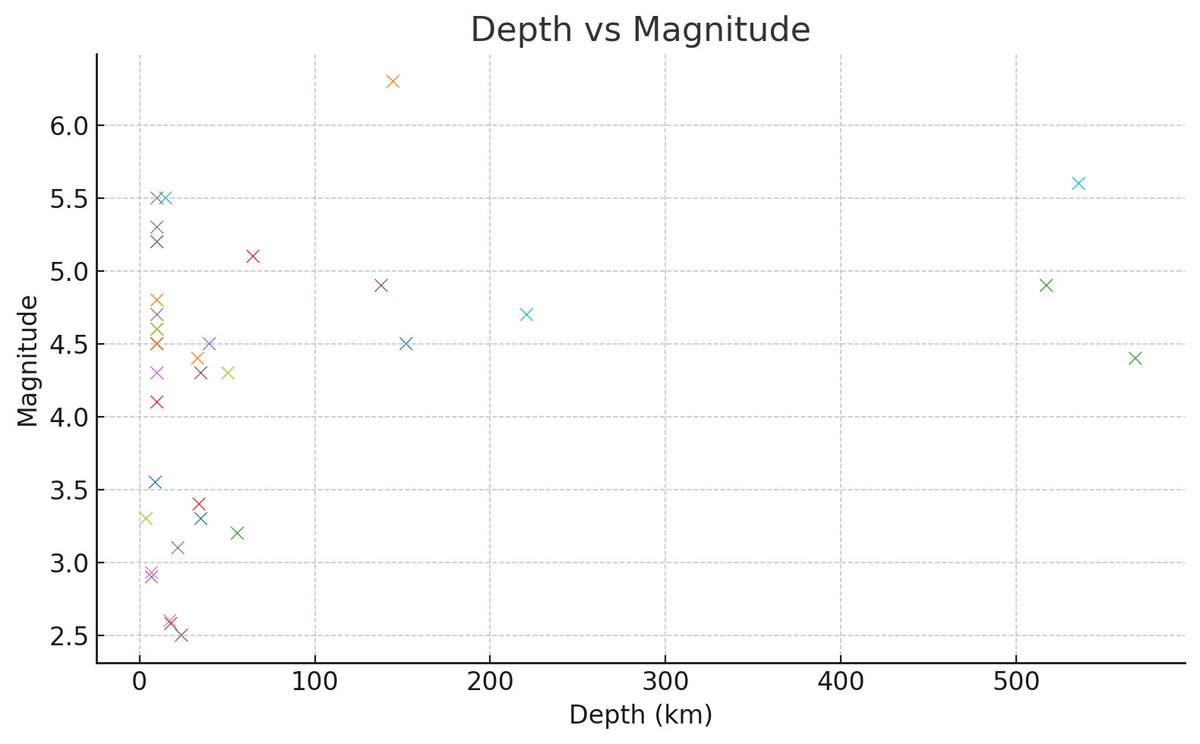[GUEST ACCESS MODE: Data is scrambled or limited to provide examples. Make requests using your API key to unlock full data. Check https://lunarcrush.ai/auth for authentication information.]
 DC @_03OG on x 1338 followers
Created: 2025-07-23 23:42:42 UTC
DC @_03OG on x 1338 followers
Created: 2025-07-23 23:42:42 UTC
🌍 Global Earthquake Snapshot – July 23, 2025
Key Stats •Total events: XX •Magnitude range: XXX to XXX •Strongest quake: M6.3 — XXX km W of Gorontalo, Indonesia •Deepest quake: ~556 km — Bandaneira Sea •Most active regions: •Puerto Rico •Kamchatka, Russia •Indonesia
Magnitude Distribution
Most earthquakes were clustered around M4.5, with a few exceeding M5.5, indicating elevated energy release globally. The histogram confirms a Gaussian-like distribution centered around M4.5–5.0.
Depth vs Magnitude •Shallow quakes (≤20 km) dominate typical crustal rupture zones — notably around Puerto Rico and Kamchatka. •Mid-depth to deep quakes (≥150 km) cluster in the Bandaneira Sea / Indonesia, possibly subducted slab interactions, hinting at pressure buildup in the mantle wedge.
Tectonic Implications (CDIGR Interpretation)
1.Indonesia (6.3 M) – Subduction Trigger Node •A clear mantle-driven rupture, possibly from dehydration embrittlement in the descending slab. •Matches CDIGR’s zero-point torque alignment under the Indo-Australian Plate. •Deep hypocenter suggests vertical mantle shear or core-induced uplift stress. 2.Kamchatka Dual Quakes (5.2 & 4.5) •Kamchatka Peninsula sits on the NW Pacific Plate compression arc, where slab rollback and plate edge pressure often precede larger chain ruptures. •The presence of paired quakes (5.2 + 4.5) within the same depth and time window is a strong precursor for larger trench or volcanic activity nearby. 3.Puerto Rico Seismic Creep (M3.5–M4.1 cluster) •A swarm of small quakes on the Puerto Rico Trench transform fault shows creeping stress — a classic CDIGR fault unzipping pattern. •This region correlates with the edge-stress migration zone along the Atlantic–Caribbean convergence. 4.High depth anomalies (>200 km) in Banda Sea •High-magnitude, high-depth events often signal mantle retraction events, where plate fragments “peel” downward. •CDIGR links these to core equilibrium realignment and pressure bleed-off following mass anomalies (e.g., GRACE Southern Hemisphere losses).
Potential Forecast Zones (Next X Days)
Using CDIGR torque drift + trench coupling: •Watch Zone 1: Kamchatka Trench or Aleutian chain — potential M6+ •Watch Zone 2: Banda Arc or Timor Sea — risk of deep rupture → tsunami •Watch Zone 3: Puerto Rico Trench creeping section — risk of M5.5+ release

XXX engagements
Related Topics coins energy russia rico puerto rico indonesia events earthquake